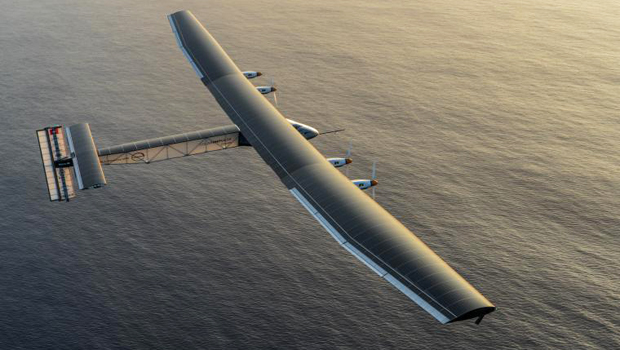Sunlight powers an aviation milestone
A remarkable aircraft is "winging it" this morning . . . completing its first round-the-world flight. As our David Pogue of Yahoo Tech explains, it's a LIGHT aircraft in more ways than one:
Some achievements are considered impossible -- right up until the moment someone does them, like building a flying machine, or walking on the Moon ... or building an airplane powered only by the Sun.
The Solar Impulse is on an impossible mission flying around the world without using a single drop of fuel. Not exactly nonstop, and not without a hitch. But it's only one flight away from completing its journey.
Two Swiss explorers have been taking turns in the pilot seat
"We are so different," Bertrand Piccard said of his partner, Andre Borschberg. "He's an engineer, I'm a medical doctor.
"Exploration is when you go into the unknown, you have no idea what's going to happen, and you try to use the doubt and the question marks to stimulate your creativity and your imagination process. And what I tell to the team almost every week is, if it's easy, everybody else would have done it."
And it's definitely not easy!
A solar plane lives in a tiny mathematical sweet spot -- limited by weight, solar panel area and batteries. The wingspan is bigger than a 747's, but the plane -- made from layers of carbon fibers -- weighs only about as much as a car, and holds only one person.
It has taken the plane about a year and five months to circle the Earth. That's because it needs ideal weather, and because -- at a mere 55 miles per hour -- it's not an especially fast plane.
Yes, it only goes as fast as a car, but as Borschberg explains, it can travel 24 hours a day. "The goal is not how fast you go to the destination. It's how you get to the destination."
It's no surprise to find Piccard driving this project; he comes from a long line of famous adventurers. So famous, the creators of "Star Trek" named Captain Jean-Luc Picard after one of his relatives. In 1931, his grandfather, Auguste Piccard, was the first man to reach the Earth's stratosphere in a balloon. His father, Jacques Piccard, was the first man to reach the deepest point of the ocean, in the Mariana Trench.
The solar plane isn't even Bertrand's first record-breaking journey. He was also the first man ever to pilot a balloon nonstop around the world, in 1999.
"It seems like, for the balloon, it was pure adventure, exploration, pioneering," said Pogue. "It seems like with Solar Impulse, there's a message as well. This is more than just a stunt, right?"
"It's not a stunt. It's exactly the challenges that our world has, to be cleaner and more energy-efficient, and to solve all the problems of pollution," Piccard said.
The flight from New York to Seville, Spain, took three days. That's a lot of time cooped up in a cockpit.
But somehow, they've figured out how to sleep ("You put the seat backward ... You switch on the autopilot. You put the alarm clock for the 20 minutes," said Piccard), and how to exercise.
"It's very important that you can keep the blood circulation correctly in the body. The best thing to relax is to put the feet up there, like this," said Piccard.
"Yeah. I tried that on Delta once. They didn't like it," Pogue laughed.
And to answer a less delicate question of Pogue's, Pixccard revealed that a toilet is under his seat -- basically sitting on a toilet for five days. "You can say it this way!" he laughed. "But you can also say that you have the best view in the world from the toilet!"
It took Piccard, Borschberg, and their corporate sponsors over a decade to get the Solar Impulse off the ground.
So what is their relationship like: Is it like a marriage? Is it like coworkers? Is it like old buddies? Do they fight?
" Sometimes we fight, but not very often," said Piccard. "But we very often disagree, which is the source of our creativity."
" I think we understand that we are, at the end, better off if we are together than we are if we are alone," Borschberg added.
For now, Solar Impulse is intended to be a very visible demonstration of how far clean technologies have come. But these guys think that all of this is only the beginning.
"I make the bet with you that in less than ten years' time, we have electrical airplanes transporting 50 people for 1,000-mile trips," said Piccard. "And this will happen."
Pogue took that bet -- and might just lose. As Bertrand Piccard pointed out before taking off for the last leg of his "impossible" flight: "The Wright brothers, they also had a single-seater flying very slowly in good weather. And 66 years later, there were two men on the Moon."
For more info:
